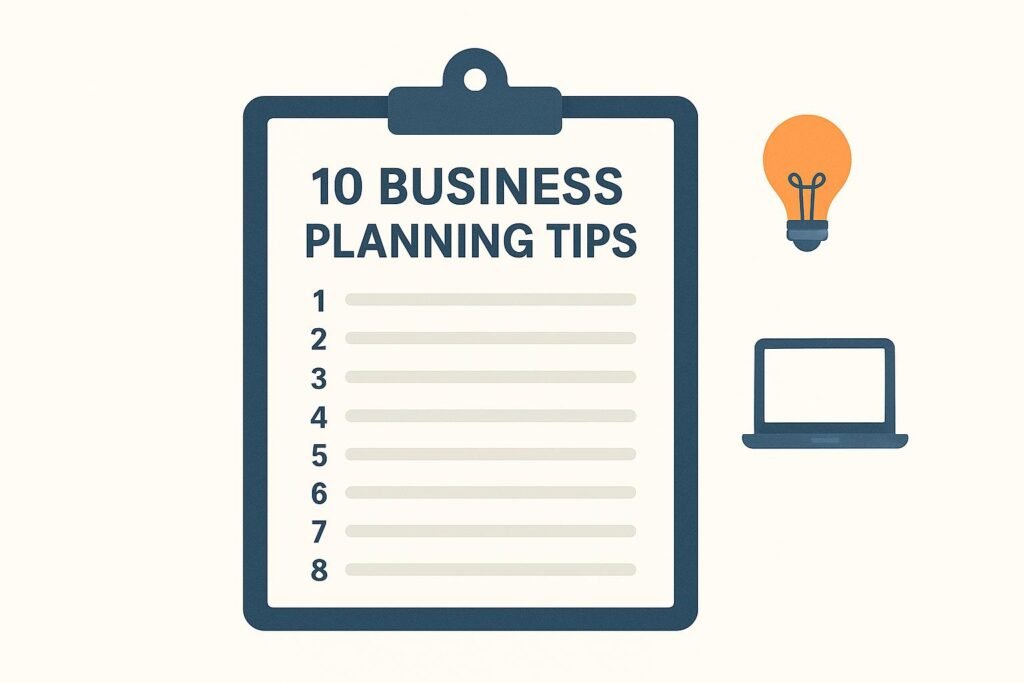
Writing a business plan is vital to launching a new business, especially if you seek external funding.
An up-to-date, comprehensive business plan can be the deciding factor for potential investors or lenders.
Even if you’re cynical about the usefulness of business plans (many of us are!), just writing one will force you to consider critical aspects of your business that you might have overlooked.
There are lots of helpful online resources to help you write a business plan. Organisations like the British Business Bank, Start Up Loans UK, and Business Gateway Scotland all provide guides and templates. Scroll down for a list of handy links.
To get you started on the right path, here are ten business planning tips to help you produce an effective plan;
1. Do your research
Most small businesses fail because they have not thoroughly researched their market. You need to determine whether there is a market for your goods or services, what competition there is, and how both are likely to change in the future.
Databases like Mintel, IBISWorld, and the Office for National Statistics (ONS) provide valuable data that can support your market research.
2. Be realistic
Small business owners are notoriously over-optimistic about their prospects. Dragons’ Den and other shows contain countless examples of business owners whose financial predictions are wildly inflated and unrealistic.
Unrealistic goals will alarm potential partners and investors, so make sure your projections can be met.
3. Define your USP (Unique Selling Point)
Does your business have a Unique Selling Point? What sets you apart from the competition, and why will customers buy from you instead of your rivals? Is it your product quality, innovative technology, or customer service?
For help with this, read Bytestart’s guide on developing a strong USP and using it to attract more customers.
4. Analyse the competition
Never underestimate what your competitors are capable of. Even if you expect to be the sole player in your business area when you launch, this may not always be true. How can you compete with existing businesses?
Use competitor analysis tools like SEMrush, or check Companies House for competitor filings to gain insights into rival businesses’ performance. Knowing who your competitors are and what they offer allows you to craft strategies to stay ahead.
5. Be honest about the risks
Identify what could go wrong with your business. Real entrepreneurs can identify their weaknesses as well as their strengths. You need to apply this thinking to your business.
Whether it’s supply chain issues, changing government regulations, or economic uncertainty, you should assess these risks and present a realistic contingency plan if things don’t work out as well as you hope.
6. Impress with the Executive Summary
This part of the business plan document is the one potential investors or your bank will look at first. It should be robust and punchy. This summarises the plan as a whole and needs to impress in one or two pages.
7. Follow the standard structure
As a business plan is a formal document, we recommend following the standard format—from outlining your objectives to the conclusion. For an orthodox structure, see Bytestart’s 12-part complete business plan guide.
You can also access free, user-friendly templates from organisations like The Prince’s Trust and Barclays Business Bank.
8. Tailor the plan for the audience
Like a CV, it’s a good idea to tailor your business plan to suit the audience—whether it’s a document for the company’s owners, your bank, or potential investors.
For example, if you’re asking your bank for a loan, focus more on financial details and how you’ll repay the capital. However, if you pitch to an investor, they may be more interested in your business’s growth potential and scalability.
9. Consider your exit strategy
One of the first things investors will look for in a business plan is the exit strategy. What are your plans for the future? In what circumstances would you exit, and how do you plan on doing so? Will you sell the company, go public, or pass it on to family?
When starting a new business, the exit process might not be the top priority, but this guide explains why it’s important to plan your exit strategy before you start your business.
10. Business plans are living documents
There is no point in having a business plan unless you update it as the business progresses. A business plan is a working document that needs to be as fluid as the business itself.
Don’t be shy of showing your plan to family, friends and colleagues, who will typically be happy to provide honest feedback.
Remember that your business plan also acts as a barometer of your success as you progress. It can also prevent you from straying away from your initial objectives and going in the wrong direction.
Some useful resources for creating your business plan
There are loads of online resources to help startups and small businesses. Here are some of our favourites:
- The Princes Trust – download the excellent free business plan pack. Very easy to follow and thorough.
- HSBC’s guide to writing a business plan is accessible and easy to follow.
- Complete business plan template from Business Gateway.
- A business plan template from the British Business Bank includes a cash flow forecast template.
- Start-up business plan template from the excellent Enterprise Nation.
- Bytestart’s 12-step guide to creating a business plan.



